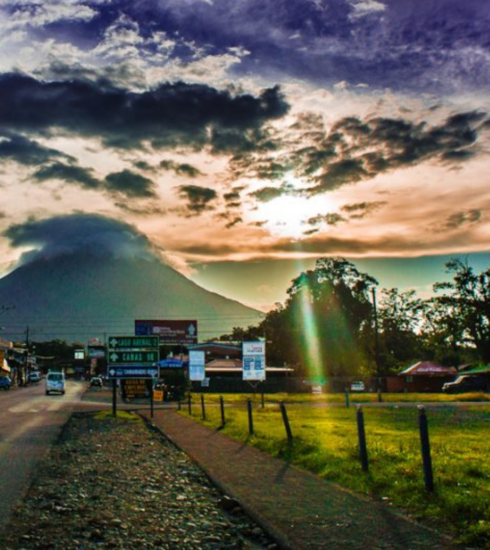Costa Rica’s International Airports SJO and LIR

INTERNATIONAL FLIGHT TIPS
At the customs desk visitors are asked to report any merchandise being brought into the country, and from there visitors exit the airport through to the outdoors. The process is most often very swift and pleasant for a vast majority of arrivals.

- No vaccines are necessary to enter Costa Rica, pharmacists within the country are well trained, and medicines are easy to find.
- Your passport must be valid during the following 6 months upon entry date.
- A return ticket or continued travel is necessary to enter the country.
The Juan Santamarian Airport is Costa Rica’s main international airport, located just a few minutes outside of San Jose in Alajuela. The airport has very recently been renovated, and is a clean, pleasant, efficiently-run airport. Passengers and employees only are allowed inside the terminal area, serving to make the airport a safe and efficient experience for arrivals and departures.
International Airports are SJO and LIB
JUAN SANTAMARIA AIRPORT (SJO)
20 km from the capital, more than a million tourists come every year to Costa Rica, , the International Airport Council (IAC) announced that the Juan Santamaria Airport in Alajuela, northwest of San Jose, is the third best airport in the Latin American and Caribbean region, as well as the regions ‘best improved’ airport when in 2010 the airport went under a significant expansion adding an immigration terminal with 28 positions as well as a new security checkpoint.
Learn MoreThe Juan Santamarian Airport is Costa Rica’s main international airport, located just a few minutes outside of San Jose in Alajuela. The airport has very recently been renovated, and is a clean, pleasant, efficiently-run airport. Passengers and employees only are allowed inside the terminal area, serving to make the airport a safe and efficient experience for arrivals and departures.
After debarking from their flight, visitors proceeed through corridors to the international area, then check through the Immigration checkpoint. Visitors in transit remain in the internation area, where they may pass the time browsing souvenier shops, book stores, sample coffees and have a meal. If the wait in transit is longer, up to 48 hours, visitors may choose to enjoy some local sights. In which case all is required is to continue through the Immigration checkpoint, and pay a transit tax when returning within 48 hours.
The carousels for claiming luggage have separate carousels for oversized luggage and special equipment (pets, surfboards, etc). Trolleys use is complimentary, and bellboys are available for a voluntary fee.
Run by a private company named Alterra Partners, the Juan Santamaria Airport has the usual range of souvenir shops, cafés, and duty free stores. There is also a food court in the airport with 3 fast food restaurants and a host of other eateries. You can also find money exchange counters and ATM. There are car rentals, taxis, airport shuttles from various main hotels and public buses right outside ready to take you where you want to go.
DANIEL ODUBER QUIROS INTERNATIONAL AIRPORT (LIR)
A mere kilometer from Highway 21, the Liberia International Airport, now known as Daniel Oduber Quiros International Airport was named for the president that served from 1974 to 1978. The airport is located 217km (135 miles) northwest of San Jose; fast becoming the airport of choice for those looking forward to vacation along the beaches of Guanacaste in the North Pacific region.
Learn MoreThe airport consists of a two story building with outdoor shaded seating areas. On the ground floor you will find the airline desks for check ins and money exchange. Upstairs are the bathrooms and a small café, as well as the Airport administration offices and a couple of airline offices. The airstrip is fitted for 737’s and 757’s which are the most common airplanes to visit the airport; as many as 45 scheduled commercial flights are expected each week.
Plans for a future terminal include a main building with gates and jetways, duty-free shops and restaurants in order to compete in size with the Juan Santamaria International airport. Taxis, airport transfers and public buses will take you either to the city of Liberia or get you on your way to the North Pacific Coastal areas.
International Flight Tips
Tourist Visa – On Entry to Costa Rica
– No vaccines are necessary to enter Costa Rica, pharmacists within the country are well trained, and medicine for the most part does not require a prescription except in specific cases.
– Your passport must be valid during the following 6 months upon entry date.
– U.S.A., Canada and most European countries do not need a VISA if you do not exceed the 90 day allotted period.
– A return ticket or continued travel is necessary to enter the country.
– Upon leaving, If you are taking an airport taxi to Juan Santamaria International Airport, the cost should be around $22.
– Normal travel protocol for both international airports requires you to check in a minimum of two hours before your flight.
– When leaving Costa Rica there is a US$ 26 departure tax on all international flights exiting the country, make sure you pay this BEFORE reaching the check-in counter.
Inside the Airport
At the customs desk visitors are asked to report any merchandise being brought into the country, and from there visitors exit the airport through to the outdoors. The process is most often very swift and pleasant for a vast majority of arrivals.
Inside the airport is a currency exchange booth. Visitors are well advised to use this booth to acquire the local currency they will need for the next day or two. Exhange rates are not updated daily inside the airport, meaning that better exchange rates may be had at your hotel or in local banks. US currency is accepted in a vast majority of establishements in Costa Rica, however denominations of $20 are the most well received. Many establishments have signs stating policy not to accept bills of $50 or $100.
Arrivals emerge through a windowed hallway to the outside doors where they meet up with their hotel or B&B host, who offer a smiling, friendly, and warm reception to whisk their visitors to their reserved lodging. Visitors might also hire a legal, licensed taxi at this point, which is a controlled process with strictly fixed, to understand rates, and a ticket booth providing visitors with a receipt for their cab fare which is then presented a driver outside. Although the pickup area is by and large a safe and secure place for arrival, con artists sometimes do make it in and blend during hours of heavy arrivals. Rules of thumb for avoiding crime at the airport: Avoid on-the-spot negotiations for a cheaper taxi fare, as this is a known approach for a thief; Take care in handing over luggage – your host and greeter will most likely speak english and will clearly introduce any assistant they have; Take care with the documents just used to proceed through Immigration and Customs (passports, permits, tickets) to avoid easy access to a pickpocket in the crowded, noisy arrival area.
Bringing Pets to Costa Rica
– Dogs and cats entering Costa Rica must have a health certificate issued by a licensed veterinarian, and endorsed by a Veterinary Service (VS) veterinarian. The examination for the certificate must be conducted within the two weeks prior to travel to Costa Rica.
Health Certificate Statements
– The dog/cat was examined and found to be healthy and free of any clinical signs of infectious disease.
– The animals were vaccinated against distemper, hepatitis, leptospirosis and parvovirus.
Vaccination Requirements:
– distemper, hepatitis, leptospirosis, parvovirus, rabies – for animals 4 months or older
– The examination for the certificate must be conducted within the two weeks prior to travel to Costa Rica.
– Please use a State of Federal US Interstate and International Certificate for Small Animals.
– Enclose rabies vaccination certificate.
– The Health Certificate does NOT need to be signed by a Notary Public, nor does it have to be authenticated by the Consulate of Costa Rica.
Animals exported in commercial lot numbers must be accompanied by an import permit.












